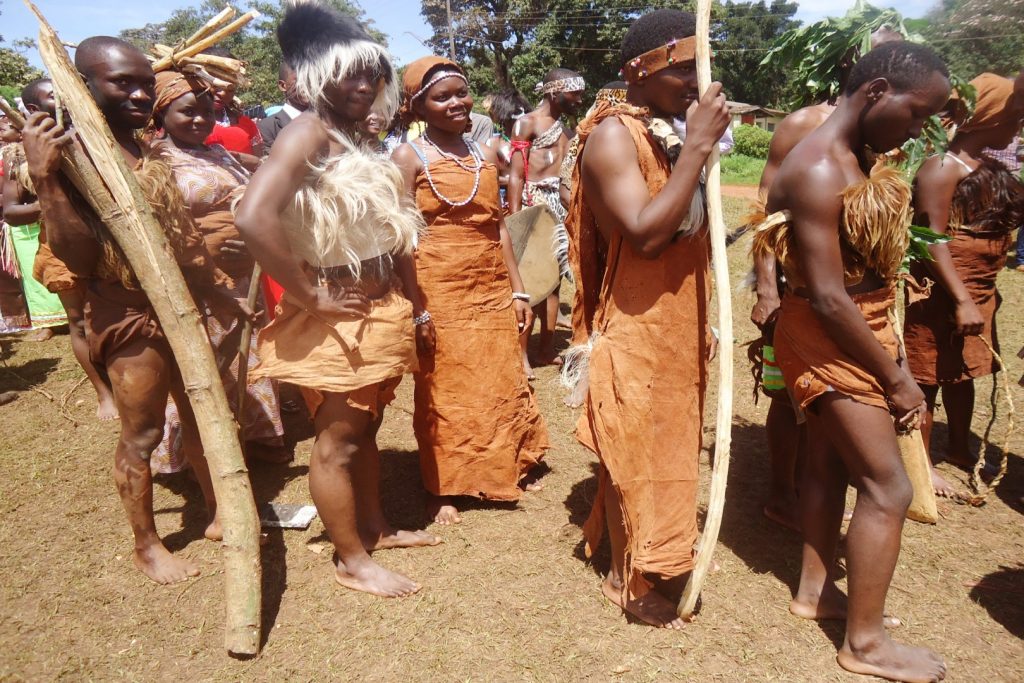Bakonjo people believe that the Rwenzori Mountains belong to them, so they jealously protect the mountains while living deep on the hills. They are also commonly or interchangeably called ‘Bakonzo’. The original name of the mountain was ‘Rwenzururu’, but due to difficulty in pronouncing the word, foreigners named it Rwenzori, which has been accepted widely in the region.
The prefix ‘Ba’ is attached to mean ‘people belonging to’, while Rwenzururu means snow. The Rwenzori mountains are a symbol of culture that defines the existence of the Bakonzo.
Origin of Bakonjo People

There are two stories told about the origin of the Bakonzo. One asserts that the Bakonjo are indigenous to the Rwenzururu mountains. Those who support this assertion say that the Rwenzori belongs to them as the garden of Eden was to Adam and Eve.
After the advent of the Toro government, the Bakonzo gradually settled on the lowlands. The mountains were blessed with reliable rainfall and lakes as natural storage tanks to supply water to both human and wild life. As a result, they found the area ideal for agriculture; both crops and live stock. So, it is believed that the ancestors of the Bakonzo emerged from caves of the Rwenzori and produced the rest of the Bakonzo.
During the expeditions from Egypt through Ethiopia, the Egyptian King Ptolemy is said to have reported the existence of short physically strong men and women who stayed in the mountains of Rwenzori. He mentions that these people used to circumcise and put a piece of bark cloth around their waists.
It is further added that Ptolemy named these mountains the ‘Mountains of the Moon’, a name which is still used today in modern times.
Another tradition asserts that the Bakonzo came from near Nalubale (Lake Victoria). Some of the works of art in Kasubi Tombs (Buganda’s cultural heritage site) in Kampala, indicate that two clans escaped from the region to the Rwenzori mountains and formed the Konzo community.
The above theory is supported by the sayings of one writer that the Konzo escaped from Buganda region after a tough clash with the Ganda after they had made a clay boat for the Kabaka that broke on the water and left many dead. The Bakonjo are found in the district of Kasese. They are the most numerous of the Rwenzori peoples, being more than the Bamba and the Bambuti (Batwa pygmies’). Physically, they are generally short and stout.
Identity
The Bakonjo-Bamba (Bakonzo-Bantu) are small people, short and dark skinned. They form the original population of the mountainous areas and forests. Their natural surrounding gave them a rich variation in small percussion instruments, wooden horns and other small portable instruments and simple dances. The musical point of view of the bushmen had a significant influence on the general population of Uganda.
The Bakonjo-bamba who are rather dark-skinned (negroid) believe in super-human powers; their gods are called Kalisa and Nyabarika. Kalisa was shown as a monster, with only one arm, one eye, one leg, and one ear, the half of a nose and only the half of a body. One half of his body was like a man.
Nyabarika was the strongest spiritual power, the ruler over life and death and a companion during the hunt etc. Shrines in form of little huts were erected for these gods, and were given sacrifices in form of food.
These mountain people were excellent hunters, so, they hunted alone as trappers or in groups. They also used dogs for hunting. The hunters played an important role within the community. The people communicated while hunting or within the family by means of quiet whistling (a form of signal).
These are the people who inhabit the villages and farms immediately along the Uganda Rwenzori front hills.
Lifestyle of Bakonjo People
Bakonjo are commonly shortened to Konzo. In Uganda the Bakonzo are an important ethnic group of about 30,000 people yet in Congo the number is much more and are known as ‘Banande’. They all belong to the Bayira, a Bantu speaking group.
Like mountain people all around the world, they are industrious and self-reliant, able to pull back into the fastness of their hills in times of turmoil in the plains, which has rewarded them with a rare social stability in both Uganda and Congo, over the last decades.
The Bakonzo bear themselves with great dignity, are conscientious about education and that wonderful core spirit of conservative African values and modest manners. They are relaxed and open. Humour is plentiful, and a good joke can last for weeks. The Bakonjo-Bamba homestead usually consists of only one or two rectangular houses and a few small store huts, widely scattered and patched on the ridges of the foothills.
The houses are made of a double layer of plaited bamboo, which is filled with clay and roofed with grass or banana thatch. Although currently, more frequently roofed with the ubiquitous African corrugated iron roof. Coffee, has been the main cash crop in the foothills, but more recently some people grow cocoa. On the plains, it is cotton.
With an expanding population, recent economic policies favoring stability have taken hold, so farms are being pushed further and higher into the mountain foothills. Because of this, there is an increasing potential for soil erosion and environmental damage caused by people’s pressure on the land.
The Bakonjo-Bamba usually marry early, with girls at about 13 or 14 years of age.
Other Cultural Inspirations
You can always contact us whenever you are interested in visiting the Bakonjo People and learn more about their culture. However, you can also enjoy a cultural tour of the Karamojong people in North-Eastern Uganda or Bamasaba of eastern Uganda.
